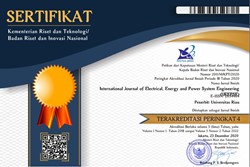Analysis of Peak Power Capacity on Rooftop Solar PV 1.25 kWp at Sun Conditions 90 Degrees
Abstract
This paper describes the optimization of energy conversion when solar radiation occurs at peak power conditions, namely at 11.00 am to 2.00 pm where the position of the sun is parallel to the layout of the PV Rooftop installation. The panels used are 5 units with the type of polycrystalline with a capacity of 1 panel unit consisting of 250 Wp. The position of the panels installed on the roof of the Andalas University building is based on an angle of 90o degrees with a position of ±255m above sea level. The advantages obtained when placed on the roof of the building are due to the minimal impact of shadow effects and environmental disturbances. Data retrieval using DC current and voltage sensors is then connected to the Arduino Uno microcontroller which is then interfaced in graphic form. Considerations in the installation of PV by reviewing the weather conditions at that time where the conditions were sunny and the air was clean with the aim that the performance when solar radiation entered the solar cells could be produced more optimally. Based on the data obtained at peak power, PV can convert DC power to 972.56 Wp. In the final stage of collecting data recorded on this PC, it can later be used as a reference for installing solar panels for household electricity scales in the West Sumatra region.
References
[1] A. J. Veldhuis and A. H. M. E. Reinders, “Reviewing the potential and cost-effectiveness of off-grid PV systems in Indonesia on a provincial level,” Renewable and Sustainable Energy Reviews, vol. 52. 2015.
[2] A. J. Veldhuis and A. H. M. E. Reinders, “Reviewing the potential and cost-effectiveness of grid-connected solar PV in Indonesia on a provincial level,” Renewable and Sustainable Energy Reviews, vol. 27. 2013.
[3] K. B. Adam, M. Ramdhani, and E. Suhartono, “A technical and economic analysis of solar PV with local tariff policy in Indonesia,” in IOP Conference Series: Materials Science and Engineering, 2020, vol. 830, no. 3.
[4] H. E. Colak, T. Memisoglu, and Y. Gercek, “Optimal site selection for solar photovoltaic (PV) power plants using GIS and AHP: A case study of Malatya Province, Turkey,” Renew. Energy, vol. 149, 2020.
[5] P. Unahalekhaka and P. Sripakarach, “Reduction of Reverse Power Flow Using the Appropriate Size and Installation Position of a BESS for a PV Power Plant,” IEEE Access, vol. 8, 2020.
[6] M. Järvelä, K. Lappalainen, and S. Valkealahti, “Characteristics of the cloud enhancement phenomenon and PV power plants,” Sol. Energy, vol. 196, 2020.
[7] P. H. A. Veríssimo, R. A. Campos, M. V. Guarnieri, J. P. A. Veríssimo, L. R. do Nascimento, and R. Rüther, “Area and LCOE considerations in utility-scale, single-axis tracking PV power plant topology optimization,” Sol. Energy, vol. 211, 2020.
[8] A. Sharma, S. Pandey, and M. Kolhe, “Global review of policies & guidelines for recycling of solar pv modules,” International Journal of Smart Grid and Clean Energy, vol. 8, no. 5. 2019.
[9] A. S. D. Rai, K. Shratriya, and A. Kurchania, “Solar panel cleaning device,” Int. J. Recent Technol. Eng., vol. 8, no. 3, 2019.
[10] S. Syafii, N. Novizon, W. Wati, and D. Juliandri, “Feasibility Study of Rooftop Grid Connected PV System for Peak Load Reduction,” Proceeding Electr. Eng. Comput. Sci. Informatics, vol. 5, no. 1, 2018.
[11] H. Satria, “Pengukuran Parameter Sistem PV Power Plant Tersambung Pada Jaringan Tenaga Listrik Berdasarkan Real Time Clock,” Setrum Sist. Kendali-Tenaga-elektronika-telekomunikasi-komputer, vol. 9, no. 2, 2020.
[12] Syafii, Wati, Novizon, and D. Juliandri, “Economic feasibility study of rooftop grid connected PV system for peak load reduction,” in International Conference on Electrical Engineering, Computer Science and Informatics (EECSI), 2018, vol. 2018-October, doi: 10.1109/EECSI.2018.8752957.
[13] B. Uzum, A. Onen, H. M. Hasanien, and S. M. Muyeen, “Rooftop solar pv penetration impacts on distribution network and further growth factors—a comprehensive review,” Electronics (Switzerland), vol. 10, no. 1. 2021.
[14] S. Sathiracheewin, P. Sripadungtham, and S. Kamuang, “Performance analysis of grid-connected PV Rooftop, at Sakon Nakhon Province, Thailand,” Adv. Sci. Technol. Eng. Syst., vol. 5, no. 4, 2020.
[15] D. Wang et al., “A method for evaluating both shading and power generation effects of rooftop solar PV panels for different climate zones of China,” Sol. Energy, vol. 205, 2020.
[16] Y. N. Chanchangi, A. Ghosh, S. Sundaram, and T. K. Mallick, “Dust and PV Performance in Nigeria: A review,” Renewable and Sustainable Energy Reviews, vol. 121. 2020.
[17] B. Plangklang, N. Thanomsat, and T. Phuksamak, “A verification analysis of power quality and energy yield of a large scale PV rooftop,” Energy Reports, vol. 2, 2016.
[18] Syafii and R. Nazir, “Performance and energy saving analysis of grid connected photovoltaic in West Sumatera,” Int. J. Power Electron. Drive Syst., vol. 7, no. 4, 2016, doi: 10.11591/ijpeds.v7i4.pp1348-1354.
[19] V. Durković and Ž. Đurišić, “Extended model for irradiation suitable for large bifacial PV power plants,” Sol. Energy, vol. 191, 2019.
[20] Z. Usman, J. Tah, H. Abanda, and C. Nche, “A critical appraisal of pv‐systems’ performance,” Buildings, vol. 10, no. 11. 2020.
[21] S. UTAMI, “Optimal Design Of Renewable Energy Systemusing Genetic Algorithm Case Study In Parangtritis,” ELKOMIKA J. Tek. Energi Elektr. Tek. Telekomun. Tek. Elektron., vol. 4, no. 2, 2018.
[22] Q. M. Aish, “Temperature Effect on Photovoltaic Modules Power Drop,” Journal Al-Khwarizmi Engineering Journal, vol. 11, no. 2. 2015.



















